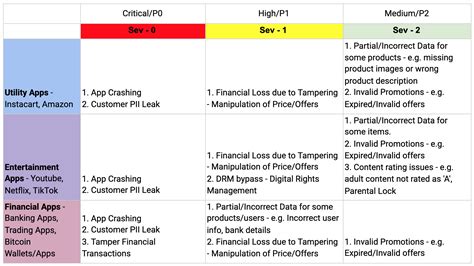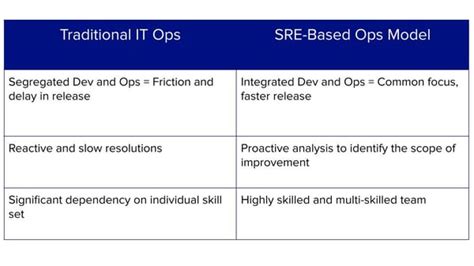Breaking News


Popular News


Learn about site reliability engineering, its implementation and impact in technology companies, and the challenges and future of SRE adoption in modern technology.In today’s fast-paced and ever-evolving technology landscape, the role of site reliability engineering (SRE) has become increasingly crucial for technology companies. SRE encompasses a set of practices and principles that aim to ensure the reliability, availability, and performance of a company’s infrastructure and systems. From understanding the fundamentals of SRE to implementing it within technology companies, the impact of SRE on the overall success of a company cannot be understated. In this blog post, we will delve into the world of SRE, exploring its importance, implementation, measurement of impact, challenges of adoption, and its future in modern technology companies. By gaining a comprehensive understanding of SRE and its implications, technology professionals can stay ahead of the curve and effectively leverage SRE to drive innovation and success within their organizations. Join us as we unravel the significance of SRE in the ever-changing technology landscape.
Contents

Site Reliability Engineering (SRE) is a discipline that incorporates aspects of software engineering and applies them to infrastructure and operations problems. It emphasizes the creation of scalable and reliable systems through automation, monitoring, and a touch of chaos engineering.
In a nutshell, SRE is about ensuring that systems are reliable and available for users. This means minimizing downtime, keeping latency low, and ensuring that systems are always operating at peak performance.
One of the key principles of SRE is the concept of error budgets. This means that teams are given a certain amount of permissible downtime or errors within a given time frame. This encourages a balance between reliability and the pace of innovation. If the error budget is used up, the team focuses on improving reliability instead of new features.
Overall, understanding Site Reliability Engineering is crucial for modern technology companies. It allows them to create more reliable and resilient systems, ultimately leading to better user experiences and a competitive edge in the market.

Site Reliability Engineering (SRE) is an essential aspect of modern technology companies, as it focuses on creating a balance between development and operations. Implementing SRE in technology companies involves integrating the principles of software engineering into the operations aspect, ensuring that systems are reliable, scalable, and efficient.
One of the key steps in implementing SRE is to establish clear communication and collaboration between development and operations teams. This involves breaking down traditional silos and fostering a culture of shared responsibility for service reliability. By doing so, technology companies can ensure that their systems are constantly monitored, and any issues are addressed in a timely manner to prevent disruptions.
Another crucial aspect of implementing SRE is automating repetitive tasks to reduce manual intervention and human error. This involves using tools and technologies to automate deployment, testing, and monitoring processes. By implementing automation, technology companies can increase their operational efficiency, reduce downtime, and improve overall system reliability.
Lastly, implementing SRE in technology companies requires measuring and monitoring the impact of reliability improvements. This involves setting up key performance indicators (KPIs) and using data-driven insights to continuously improve system performance and reliability. By measuring the impact of SRE, technology companies can make informed decisions and prioritize efforts to address the most critical reliability issues.

Site Reliability Engineering (SRE) has become an integral part of modern technology companies, but how do we measure its impact? One way to measure the impact of SRE is through uptime. Monitoring the percentage of time that a service is available can provide insight into the effectiveness of SRE practices. By tracking uptime, companies can quantify the impact of SRE on the reliability of their systems.
Another important metric for measuring the impact of SRE is mean time to recovery (MTTR). MTTR measures the average time it takes to recover from a service outage. A lower MTTR indicates that SRE practices are effectively reducing downtime and minimizing impact on users. By tracking MTTR, companies can assess the effectiveness of their SRE efforts in maintaining system reliability.
Additionally, error budget can be used to measure the impact of SRE. Error budget is the amount of acceptable downtime within a given period, and it provides a way to balance the need for system improvements with the risk of service disruptions. By managing error budget effectively, companies can evaluate the trade-offs between innovation and reliability, and measure the impact of SRE on their overall service quality.
| Metrics | Measurement |
|---|---|
| Uptime | Percentage of time service is available |
| MTTR | Average time to recover from outage |
| Error Budget | Amount of acceptable downtime |
Overall, measuring the impact of SRE requires careful tracking of key metrics such as uptime, MTTR, and error budget. By quantifying the effectiveness of SRE practices, companies can continually assess and improve their reliability efforts, and ultimately provide better service to their users.

Implementing Site Reliability Engineering (SRE) in technology companies is not without its challenges. One of the main challenges is the resistance to change from the existing organizational culture. Many technology companies are set in their ways and have been operating with traditional IT Operations for years. Convincing the management and employees to adopt a new approach such as SRE can be met with skepticism and pushback.
Another challenge of SRE adoption is the lack of skilled personnel. SRE requires a blend of skills that are not typically found in traditional IT departments. Finding individuals who possess a deep understanding of software development as well as systems administration can be a difficult task. Additionally, training existing employees to develop these skills can take time and resources.
In addition to resistance and skills gap, another challenge of SRE adoption is the complexity of implementing new tools and processes. SRE involves the use of advanced technologies and methodologies such as containerization, cloud computing, and continuous integration/continuous deployment (CI/CD). Integrating these tools and processes into existing systems can be daunting and may require significant investment and overhaul of the infrastructure.
Overall, the challenges of SRE adoption are complex and multifaceted, ranging from cultural resistance to lack of skilled personnel and technical complexities. However, overcoming these challenges is crucial for technology companies looking to modernize their IT operations and achieve greater reliability and efficiency in their services.

Site Reliability Engineering (SRE) has been playing a crucial role in the technology industry, ensuring the reliability and performance of complex systems and infrastructure. As technology continues to evolve at a rapid pace, the future of SRE in technology looks promising, with its significance only expected to grow. With the increasing reliance on digital services and the demand for seamless user experiences, the need for SRE expertise is likely to become even more critical.
One of the key aspects shaping the future of SRE in technology is the integration of artificial intelligence and machine learning. These technologies are revolutionizing the way companies manage and optimize their systems, and SRE teams can leverage AI and ML to automate routine tasks, predict potential issues, and proactively address performance bottlenecks. This integration will not only enhance the efficiency and effectiveness of SRE practices but also enable organizations to achieve higher levels of system reliability and resilience.
Another important trend influencing the future of SRE is the shift towards cloud-native architectures and microservices. As more companies embrace cloud computing and containerization, the complexity of their infrastructures increases, posing new challenges for SRE teams. The future of SRE will require a deep understanding of these modern architectures and the ability to adapt SRE practices to the unique demands of cloud-native environments, distributed systems, and interconnected microservices.
| Challenges | Opportunities |
|---|---|
| Complexity of cloud-native architectures | Collaboration with DevOps for seamless integration |
| Scalability and performance optimization | Enhanced automation through AI and ML |

What is site reliability engineering (SRE)?
SRE is a discipline that incorporates aspects of software engineering and applies them to infrastructure and operations problems. The main goals are to create scalable and highly reliable software systems.
What are the key responsibilities of a Site Reliability Engineer?
SREs are responsible for defining and maintaining service level objectives, ensuring system scalability, monitoring and responding to system alerts, and automating repetitive tasks.
How does site reliability engineering differ from traditional operations?
Traditional operations teams focus on resolving immediate issues, while SREs focus on anticipation and prevention of future issues. SREs also emphasize automation and an engineering approach to solving operational problems.
What are the benefits of implementing SRE in a technology company?
SRE practices can lead to increased system reliability, improved scalability, reduced manual intervention, and a better understanding of system performance.
How can a company transition to an SRE model?
A company can transition to SRE by establishing service level objectives, adopting an error budget policy, implementing automation tools, and fostering a culture of collaboration between development and operations teams.
What are some common challenges faced by SRE teams?
Common challenges include balancing new feature development with reliability improvements, managing complex distributed systems, and anticipating and preventing system failures.
What are some popular tools used by SREs?
Popular tools include monitoring and alerting systems like Prometheus and Grafana, incident response tools like PagerDuty, and automation and configuration management tools like Ansible and Terraform.